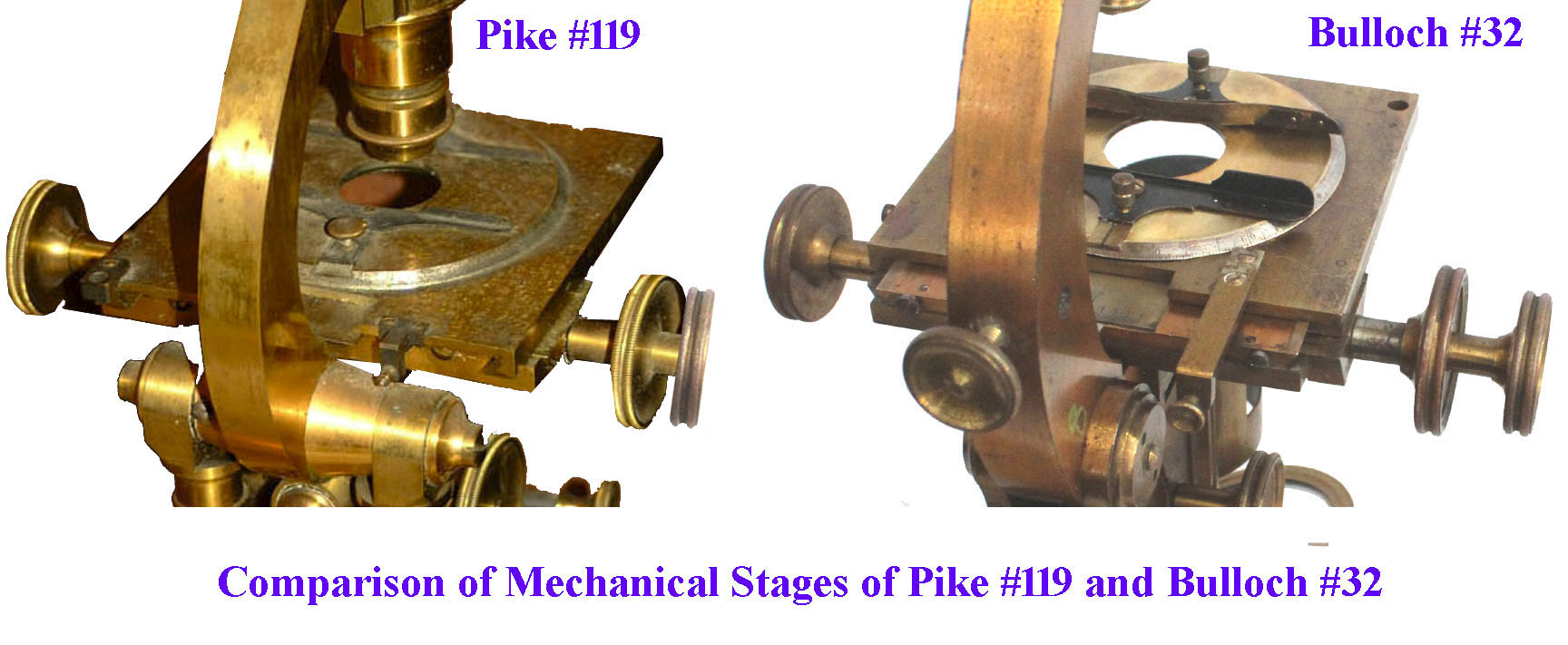| DESCRIPTION | HISTORY | CONDITION |
Please Click On Any Picture for a Larger Version

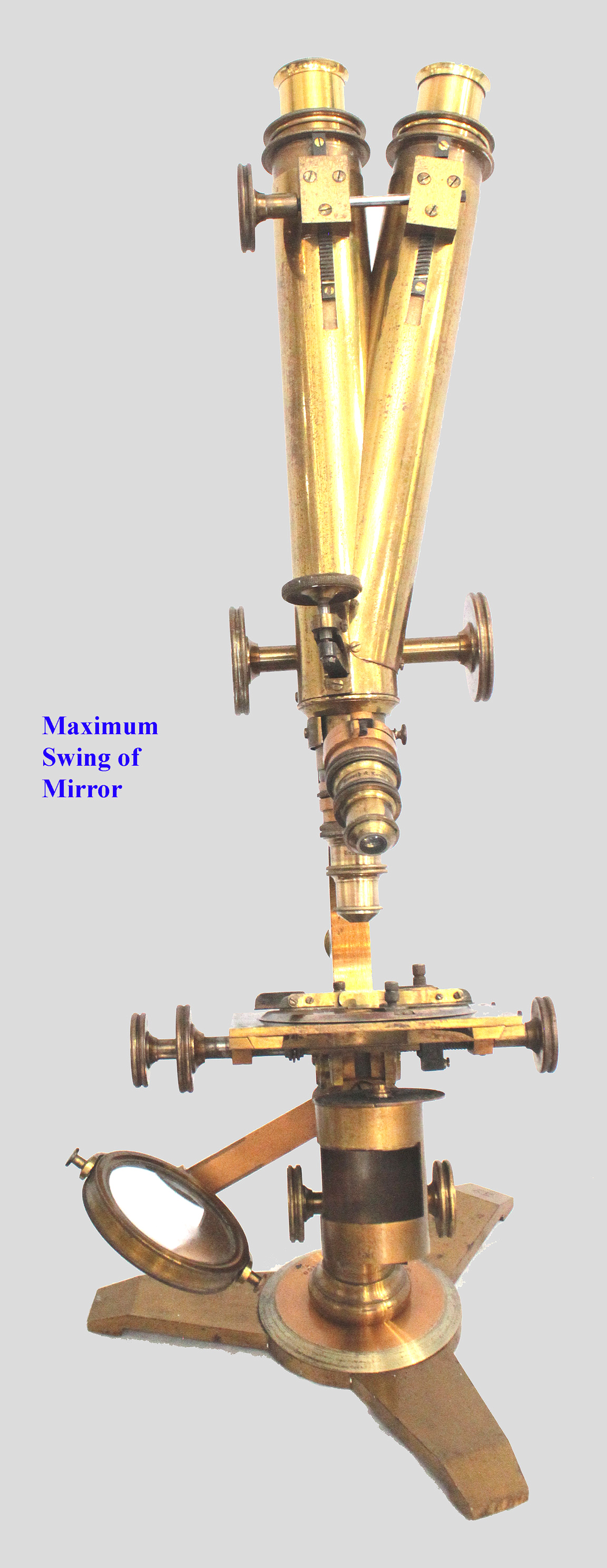 This microscope sits on a flat equilateral tripod; this tripod is sometimes referred to as an
This microscope sits on a flat equilateral tripod; this tripod is sometimes referred to as an Americantype but was used in England long before*. The limb attaches to a single pillar which is attached to a rotating disk with silvered scale which rotates on the foot. The signature of
W.H. Bulloch Chicagois on this disk. The binocular tube has coarse focus by rack and pinion, and fine focus by short lever to the nosepiece. Interocular distance is also by rack and pinion. There is a slide-out drawer for the prism in the nosepiece to easily switch to monocular viewing at higher powers. There is a Bausch & Lomb double objective changer attached to the nosepiece. The substage is focused by rack and pinion and the substage assembly has a wheel of apertures installed at the top. The long cylindrical substage assembly has a space between its upper and lower parts, similar to the substage assembly on some later Bulloch first class microscopes and also the first class microscope of Smith and Beck. This allows separate accessories to be mounted on the top and bottom portion and the space in between would allow the use of swing-out selenites(as it does in the Smith & Beck example on this site). The large plano and concave mirror is 2 inches in diameter (excluding the brass portion). The mirror sits in a gimbal and can slide up and down the rectangular tailpiece. The tailpiece for the mirror is separate from the substage, and can swing left and right, but it cannot swing above the stage. This type of mirror assembly was also found on Bulloch's
Cmodel, as well as Zentmayer's Army Hospital model. Swinging tailpieces which could not swing above the stage were also found on Bulloch's
A,
D,
E, and
Fmodels. The limb has a round hole in it to accept an accessory, and has a knurled knob to secure such an accessory. This is a feature found on Lister Limb microscopes such as that of James Smith as early as the 1840's.
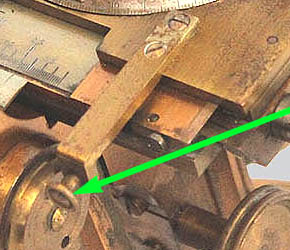
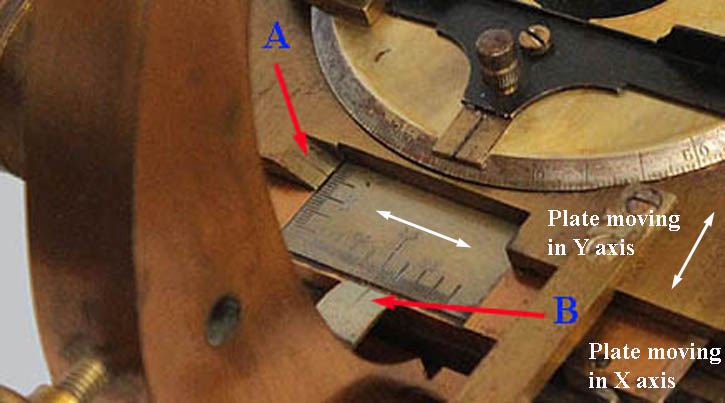 The mechanical stage is square. The rotating slide-holding assembly, with a silvered calibrated scale on its edge, has two sliding slide-holders, one with brass leaf springs to help secure a slide in place. The concentric stage controls activate the X-motion(right-left) by screw and Y axis (front-back)movement by a fusee chain. A small knob (green arrow, left) is attached to a bracket at the rear of the top stage plate to adjust the tension on the fusee chain. There is a silvered calibration plate on the rear of the plate of the stage moving in the X-axis. The top plate of the stage, which moves in the Y-axis, has an indicator line (A) on its left side to register against a scale found on the left side of the silvered plate. X axis (right-left motion) of the stage registers against a fixed silvered piece(B) attached to the front side of the limb. There is an L-shaped removable brass piece on the left side of the stage slide-holder to register a slide for allowing one to locate an area previously noted by using the calibrated scales. This stage is virtually identical to a mechanical stage used by Pike in the same era, and Zentmayer before him. The slide holder is identical to those used by Pike and Zentmayer with front and rear parts which can be moved back and forth. On the right front corner of the stage is a hole to accept accessories such as a stage forceps.
The mechanical stage is square. The rotating slide-holding assembly, with a silvered calibrated scale on its edge, has two sliding slide-holders, one with brass leaf springs to help secure a slide in place. The concentric stage controls activate the X-motion(right-left) by screw and Y axis (front-back)movement by a fusee chain. A small knob (green arrow, left) is attached to a bracket at the rear of the top stage plate to adjust the tension on the fusee chain. There is a silvered calibration plate on the rear of the plate of the stage moving in the X-axis. The top plate of the stage, which moves in the Y-axis, has an indicator line (A) on its left side to register against a scale found on the left side of the silvered plate. X axis (right-left motion) of the stage registers against a fixed silvered piece(B) attached to the front side of the limb. There is an L-shaped removable brass piece on the left side of the stage slide-holder to register a slide for allowing one to locate an area previously noted by using the calibrated scales. This stage is virtually identical to a mechanical stage used by Pike in the same era, and Zentmayer before him. The slide holder is identical to those used by Pike and Zentmayer with front and rear parts which can be moved back and forth. On the right front corner of the stage is a hole to accept accessories such as a stage forceps.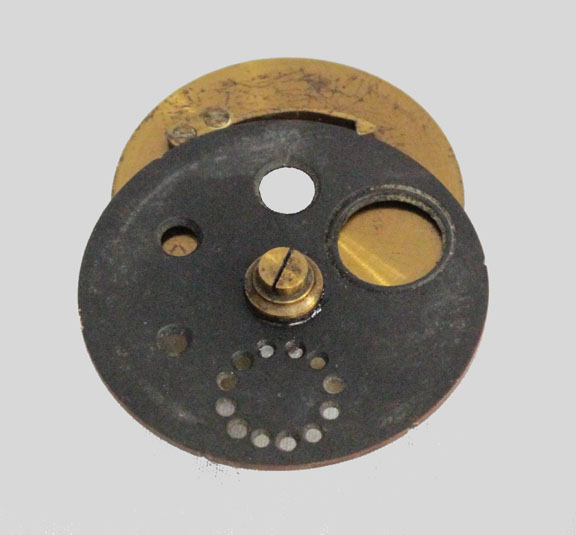 The microscope did not come to me with accessories, other than the Bausch & Lomb double objective changer, and the wheel of apertures(left). The wheel has a total of 5 openings and a brass spring stop to hold each in position. One position has no aperture. The aperture with the 12 little holes is used for oblique illumination. The microscope is now equipped with contemporary Bausch & Lomb objectives, and eyepieces similar to what it would originally have had. Since Bulloch never made the optical components, and supplied optics by Wales, B & L, etc, this is entirely appropriate.
The microscope did not come to me with accessories, other than the Bausch & Lomb double objective changer, and the wheel of apertures(left). The wheel has a total of 5 openings and a brass spring stop to hold each in position. One position has no aperture. The aperture with the 12 little holes is used for oblique illumination. The microscope is now equipped with contemporary Bausch & Lomb objectives, and eyepieces similar to what it would originally have had. Since Bulloch never made the optical components, and supplied optics by Wales, B & L, etc, this is entirely appropriate.
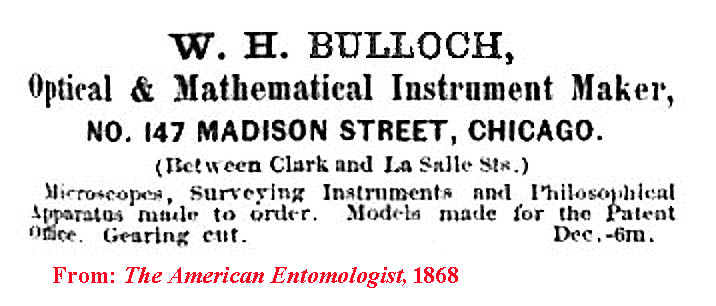 earliest advertisement from Bulloch that I am aware of is shown to the left and dates to 1868, but has no illustrations. In 1869 Bulloch was a founding member of the State Microscopical Society of Illinois. From October 8 to October 10, 1871 the Great Chicago Fire consumed much of Chicago and Bulloch lost everything. He temporarily went to work for Tolles in Boston. He apparently was back in Chicago by 1872. According to an article in the JRMS, the Sector Microscope was first produced in 1873, and the known engraving of it illustrates a serial number of 52. By 1875, he was making his stand A.
earliest advertisement from Bulloch that I am aware of is shown to the left and dates to 1868, but has no illustrations. In 1869 Bulloch was a founding member of the State Microscopical Society of Illinois. From October 8 to October 10, 1871 the Great Chicago Fire consumed much of Chicago and Bulloch lost everything. He temporarily went to work for Tolles in Boston. He apparently was back in Chicago by 1872. According to an article in the JRMS, the Sector Microscope was first produced in 1873, and the known engraving of it illustrates a serial number of 52. By 1875, he was making his stand A. A1 or Congressmicroscope. Since the fire took place in early October of 1871, and he left for Boston shortly thereafter, losing everything, it is unlikely he had supplies or tools to make many microscopes in Chicago when he returned there in 1872. Taken together, all the above information suggests this microscope was made in the late 1860s. The dating is made more difficult knowing that some of his stands have no serial number, and that no exact records document how many microscopes he made per year from 1866 to 1870. It is unknown when he started to use serial numbers.
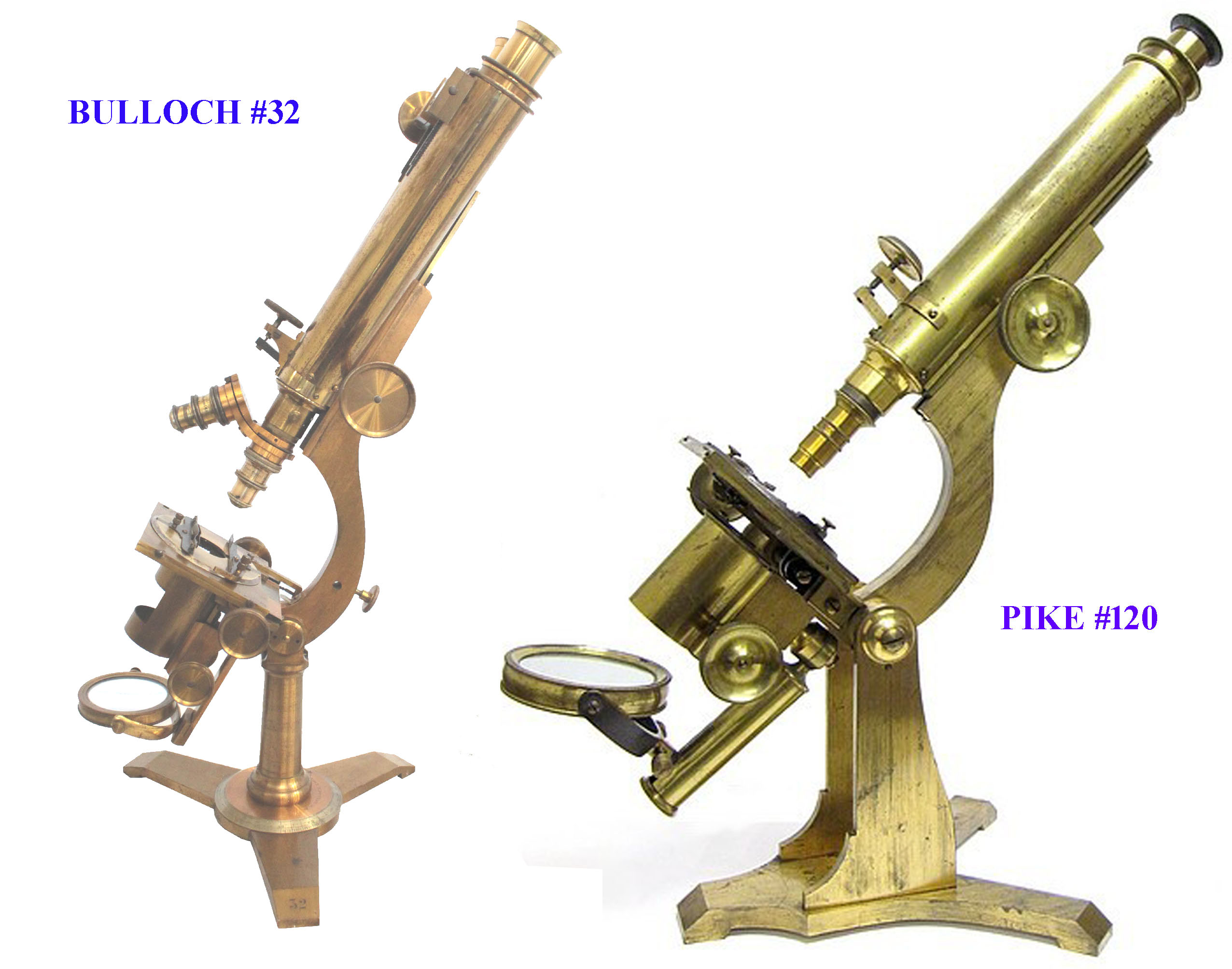 It has been said that little is known of Bulloch's early microscopes. As seen in the two images shown here, at least this example of Bulloch's early production very closely resembles what Pike and Zentmayer sold. The mechanical stage design, square with calibrated rotating center, was sold by Pike, and a similar stage is also featured on many of Zentmayer's Grand American microscopes as well. The microscope is very similar to the Pike example shown to the right, with the exception of a single pillar rather than the flat uprights on a Y-foot; Pike also made feet with double pillar supports (see bottom image below), on a calibrated disk on an equilateral flat tripod, very similar to what Bulloch did on #32 (but with a single pillar). Since Bulloch worked for many years for Pike it is not surprising this microscope has many similarities to some Pike models.
It has been said that little is known of Bulloch's early microscopes. As seen in the two images shown here, at least this example of Bulloch's early production very closely resembles what Pike and Zentmayer sold. The mechanical stage design, square with calibrated rotating center, was sold by Pike, and a similar stage is also featured on many of Zentmayer's Grand American microscopes as well. The microscope is very similar to the Pike example shown to the right, with the exception of a single pillar rather than the flat uprights on a Y-foot; Pike also made feet with double pillar supports (see bottom image below), on a calibrated disk on an equilateral flat tripod, very similar to what Bulloch did on #32 (but with a single pillar). Since Bulloch worked for many years for Pike it is not surprising this microscope has many similarities to some Pike models.